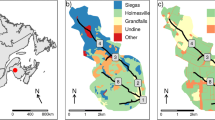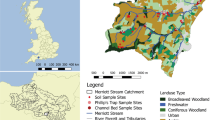Abstract
This paper describes a study examining the potential of mineral magnetic, geochemical and organic properties to determine if a 2003 wildfire in a catchment in British Columbia, Canada, caused a change in the sources of the suspended sediment transported in the channel relative to a nearby unburnt (reference) catchment. The results show that some of the properties offer the potential to determine sediment sources in the unburnt catchment. However, the 2003 wildfire modified the concentrations of some properties and this can either compromise or enhance their ability as tracers in the burnt catchment. At present, the source tracing results are inconclusive. This has implications for the use of certain properties as fingerprints and raises important issues about approaches to sediment source identification.


Similar content being viewed by others
References
Biickert, S. (1999). The effect of pulp mill effluent on fine-grained sediment morphology and storage in the Fraser River at Prince George, British Columbia. MSc Thesis, UNBC, Canada.
Blake, W. H., Wallbrink, P. J., Doerr, S. H., Shakesby, R. A., & Humphreys, G. S. (2006). Magnetic enhancement in wildfire-affected soil and its potential for sediment-source ascription. Earth Surface Processes and Landforms, 31, 249–264.
Cerda, A., & Lasanta, T. (2005). Long-term erosional responses after fire in the Central Pyrenees. 1. Water and sediment yield. Catena, 60, 59–80.
Certini G. (2005). Effects of fire on properties of forest soils: A review. Oecologia, 143, 1–10.
Marafa, L. M., & Chau, K. C. (1999). Effect of hill fire on upland soil in Hong Kong. Forest Ecology and Management, 120, 97–104.
Pausas, J. G. (2004). Change in fire and climate in the eastern Iberian Peninsula (Mediterranean Basin). Climate Change, 63, 337–350.
Petticrew, E. L., Owens, P. N., & Giles, T. R. (in press). Wildfire effects on the quantity and composition of suspended and gravel-stored sediments. Water, Air, and Soil Pollution.
Rummery, T. A., Bloemendal, J., Dearing, J. A., Oldfield, F., & Thompson, R. (1979). The persistence of fire-induced magnetic oxides in soil and lake sediments. Annales de Géophysique, 35, 103–107.
Walling, D. E. (2005). Tracing suspended sediment sources in catchments and river systems. Science of the Total Environment, 344, 159–184.
Acknowledgements
Thanks are extended to Tim Giles (BC Ministry of Forests), Dan Moore (University of British Columbia) and Phillip Krauskopf (University of Northern British Columbia) for logistical support and assistance in the field, and to Richard Hartley and Kevin Solman (University of Plymouth) for undertaking laboratory analysis. NSERC, the Royal Society and the universities of Cranfield, Plymouth and UNBC are thanked for financial support.
Author information
Authors and Affiliations
Corresponding author
Rights and permissions
About this article
Cite this article
Owens, P.N., Blake, W.H. & Petticrew, E.L. Changes in Sediment Sources following Wildfire in Mountainous Terrain: A Paired–Catchment Approach, British Columbia, Canada. Water Air Soil Pollut: Focus 6, 637–645 (2006). https://doi.org/10.1007/s11267-006-9048-z
Published:
Issue Date:
DOI: https://doi.org/10.1007/s11267-006-9048-z




